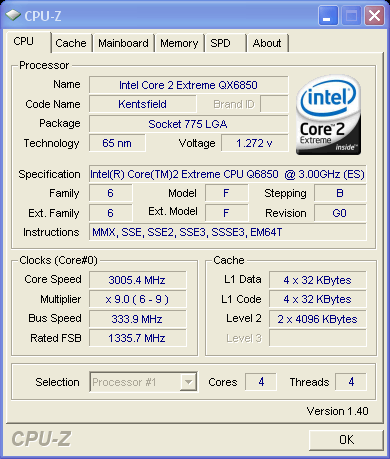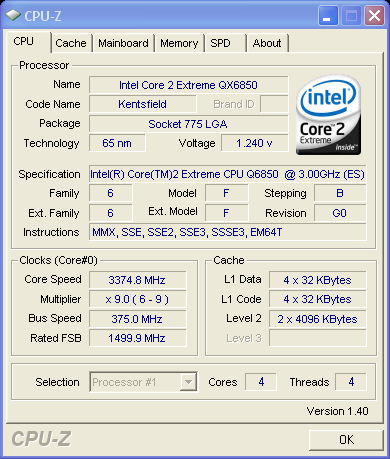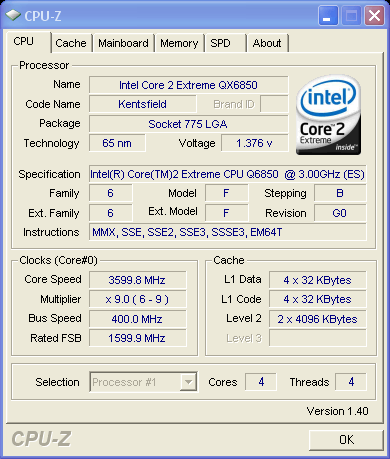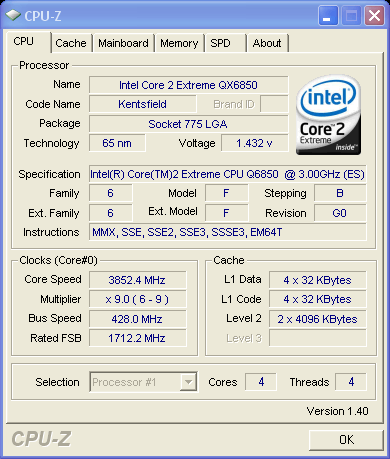- Qualcomm Launches Snapdragon 4 Gen 2 Mobile Platform
- AMD Launches Ryzen PRO 7000 Series Mobile & Desktop Platform
- Intel Launches Sleek Single-Slot Arc Pro A60 Workstation Graphics Card
- NVIDIA Announces Latest Ada Lovelace Additions: GeForce RTX 4060 Ti & RTX 4060
- Maxon Redshift With AMD Radeon GPU Rendering Support Now Available
Intel Core 2 Extreme QX6850 Quad-Core
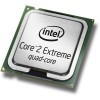
Intel today is announcing their 1333FSB Core 2 line-up, which consists of three dual-cores, including the E6750 we previewed a few weeks ago, and also the 3.0GHz quad-core that we are testing out today. Read on as we explore all of what Intel’s latest flagship processor has to offer.
Page 11 – Overclocking
Because the QX6850 is not based on a different microarchitecture from the previous QX6700 and QX6800 models, most already know what to expect performance wise, especially since many have already achieved and surpassed the 3.0GHz clock speed with overclocking. The QX6850 will undoubtedly become the processor that die-hard overclockers will use though, especially those with exotic cooling setups. As I found out, even with a simple water-cooling kit, overclocking has potential.
Intel could have marketed the QX6850 as a 3.33GHz processor, as overclocking to that point is not only easy, but incredibly stable. Thanks to the unlocked multiplier (6 – 11), you could set a multiplier to 10 and not deal with it any further. The voltage that the board automatically sets for the CPU will be enough to deem it as stable.
For an overclock to be considered stable, 3D Mark 06 is looped three times, followed by at least eight straight hours of SP2004’s Small FFT test, one instance per core. The computer must also be turned on and off multiple times, to make sure that the motherboard is going to cooperate. As a final test, the computer is left turned off for at least a half-hour, then turned back on to make sure it performs normally.
Well, after such testing, 3.37GHz was declared the max overclock on stock voltages. I proceeded to play through my installed selection of games and stress the CPU with all available methods and didn’t run into a single issue. According to Everest 4.0, the core temps did not increase with the overclock. Both the Core 1 and 2 topped out at 80°C at both settings (66°C total CPU temp), in a 77°F room temperature. This is why I consider it to be a completely stable and ‘free’ overclock. 10% frequency boost for simply selecting a different multiplier.
One last thing I will mention about this overclock, is that by default the motherboard sets the Vcore to 1.325v, which is actually higher than what I used. I always manually set the Vcore to 1.3v, as it’s a modest amount of voltage and any stock CPU shouldn’t require more than that. So, if you want your CPU to run a wee bit cooler, you should manually test out 1.3v with your copy, and go even lower should the processor continue to be stable. Quad-Cores can run very hot, so anything you can do to lower the temps is a good move.
Between 1.3v and 1.4v, overclocking ability was not greatly increased. To push further, I set the Vcore to 1.4v which allowed an overclock of 3.6GHz, also stable. The problem here though, is that Everest was reporting much higher temperatures for Core 1 and Core 2, to the point that the setting should not be used for long periods of time unless you have very nice cooling.
The accuracy of Everest can be debated, however, which we covered on the previous page. How far did we manage to push the QX6850, while risking it all? 1.5v+ and higher didn’t work well for stability, but 1.45v kept things rather stable while keeping the CPU at a ‘reasonable’ temperature. Utilizing a FSB of 428MHz and a multiplier of 9, we had a nice 3.85GHz clock speed.
I don’t recommend trying for the same overclock on your own CPU, as it’s treading into dangerous territory. If you have a high-quality water-cooling setup, peltier or anything else that keeps CPU temperatures far more reasonable than what air or a cheap water-cooling setup can avail you, then have a go. Major overclocks are not needed regardless, as this is already the fastest processor available today.
Usefulness of an unstable overclock aside, what’s fun to note is the fact that it almost outperforms Intel’s own 8-Core Xeon setup that they were showing off at this years CES. While their machine accomplished a 3D Mark 06 CPU score of 6,089, our machine with 50% of the available cores hit 6,056. Sure, it can be argued that their system was more stable than ours, but where’s the fun in that?
Support our efforts! With ad revenue at an all-time low for written websites, we're relying more than ever on reader support to help us continue putting so much effort into this type of content. You can support us by becoming a Patron, or by using our Amazon shopping affiliate links listed through our articles. Thanks for your support!




